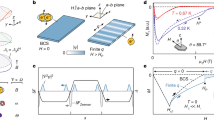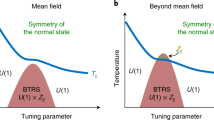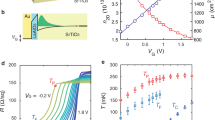Abstract
Fermi liquid theory forms the basis for our understanding of the majority of metals: their resistivity arises from the scattering of well defined quasiparticles at a rate where, in the low-temperature limit, the inverse of the characteristic time scale is proportional to the square of the temperature. However, various quantum materials1,2,3,4,5,6,7,8,9,10,11,12,13,14,15—notably high-temperature superconductors1,2,3,4,5,6,7,8,9,10—exhibit strange-metallic behaviour with a linear scattering rate in temperature, deviating from this central paradigm. Here we show the unexpected signatures of strange metallicity in a bosonic system for which the quasiparticle concept does not apply. Our nanopatterned YBa2Cu3O7−δ (YBCO) film arrays reveal linear-in-temperature and linear-in-magnetic field resistance over extended temperature and magnetic field ranges. Notably, below the onset temperature at which Cooper pairs form, the low-field magnetoresistance oscillates with a period dictated by the superconducting flux quantum, h/2e (e, electron charge; h, Planck’s constant). Simultaneously, the Hall coefficient drops and vanishes within the measurement resolution with decreasing temperature, indicating that Cooper pairs instead of single electrons dominate the transport process. Moreover, the characteristic time scale τ in this bosonic system follows a scale-invariant relation without an intrinsic energy scale: ħ/τ ≈ a(kBT + γμBB), where ħ is the reduced Planck’s constant, a is of order unity7,8,11,12, kB is Boltzmann’s constant, T is temperature, μB is the Bohr magneton and γ ≈ 2. By extending the reach of strange-metal phenomenology to a bosonic system, our results suggest that there is a fundamental principle governing their transport that transcends particle statistics.
This is a preview of subscription content, access via your institution
Access options
Access Nature and 54 other Nature Portfolio journals
Get Nature+, our best-value online-access subscription
$29.99 / 30 days
cancel any time
Subscribe to this journal
Receive 51 print issues and online access
$199.00 per year
only $3.90 per issue
Buy this article
- Purchase on Springer Link
- Instant access to full article PDF
Prices may be subject to local taxes which are calculated during checkout




Similar content being viewed by others
Data availability
The data that support the plots within this paper are available from the Zenodo data repository, https://doi.org/10.5281/zenodo.5603259. Source data are provided with this paper.
References
Anderson, P. W. The Theory of Superconductivity in the High-TC Cuprates (Princeton Univ. Press, 1998).
Keimer, B., Kivelson, S. A., Norman, M. R., Uchida, S. & Zaanen, J. From quantum matter to high-temperature superconductivity in copper oxides. Nature 518, 179–186 (2015).
Zaanen, J. Why the temperature is high. Nature 430, 512–513 (2004).
Jin, K., Butch, N. P., Kirshenbaum, K., Paglione, J. & Greene, R. L. Link between spin fluctuations and electron pairing in copper oxide superconductors. Nature 476, 73–75 (2011).
Greene, R. L., Mandal, P. R., Poniatowski, N. R. & Sarkar, T. The strange metal state of the electron-doped cuprates. Annu. Rev. Condens. Matter Phys. 11, 213–229 (2020).
Taillefer, L. Scattering and pairing in cuprate superconductors. Annu. Rev. Condens. Matter Phys. 1, 51–70 (2010).
Giraldo-Gallo, P. et al. Scale-invariant magnetoresistance in a cuprate superconductor. Science 361, 479–481 (2018).
Legros, A. et al. Universal T-linear resistivity and Planckian dissipation in overdoped cuprates. Nat. Phys. 15, 142–147 (2019).
Varma, C. M., Littlewood, P. B., Schmitt-Rink, S., Abrahams, E. & Ruckenstein, A. E. Phenomenology of the normal state of Cu-O high-temperature superconductors. Phys. Rev. Lett. 63, 1996–1999 (1989).
Varma, C. M. Linear in temperature resistivity and associated mysteries including high temperature superconductivity. Rev. Mod. Phys. 92, 031001 (2020).
Patel, A. A. & Sachdev, S. Theory of a Planckian metal. Phys. Rev. Lett. 123, 066601 (2019).
Bruin, J. A. N., Sakai, H., Perry, R. S. & Mackenzie, A. P. Similarity of scattering rates in metals showing T-linear resistivity. Science 339, 804–807 (2013).
Hayes, I. M. et al. Scaling between magnetic field and temperature in the high-temperature superconductor BaFe2(As1−xPx)2. Nat. Phys. 12, 916–919 (2016).
Doiron-Leyraud, N. et al. Correlation between linear resistivity and Tc in the Bechgaard salts and the pnictide superconductor Ba(Fe1−xCox)2As2. Phys. Rev. B 80, 214531 (2009).
Cao, Y. et al. Strange metal in magic-angle graphene with near Planckian dissipation. Phys. Rev. Lett. 124, 076801 (2020).
Zaanen, J. Planckian dissipation, minimal viscosity and the transport in cuprate strange metals. SciPost Phys. 6, 061 (2019).
Cao, C. et al. Universal quantum viscosity in a unitary Fermi gas. Science 331, 58–61 (2011).
Kovtun, P. K., Son, D. T. & Starinets, A. O. Viscosity in strongly interacting quantum field theories from black hole physics. Phys. Rev. Lett. 94, 111601 (2005).
Zaanen, J., Liu, Y., Sun, Y.-W. & Schalm, K. Holographic Duality in Condensed Matter Physics (Cambridge Univ. Press, 2015).
Hartnoll, S. A., Lucas, A. & Sachdev, S. Holographic quantum matter. Preprint at https://arxiv.org/abs/1612.07324v1 (2016).
Kapitulnik, A., Kivelson, S. A. & Spivak, B.Anomalous metals: failed superconductors. Rev. Mod. Phys. 91, 011002 (2019).
Phillips, P. & Dalidovich, D. The elusive Bose metal. Science 302, 243–247 (2003).
Mason, N. & Kapitulnik, A. Dissipation effects on the superconductor–insulator transition in 2D superconductors. Phys. Rev. Lett. 82, 5341–5344 (1999).
Saito, Y., Kasahara, Y., Ye, J., Iwasa, Y. & Nojima, T. Metallic ground state in an ion-gated two-dimensional superconductor. Science 350, 409–413 (2015).
Breznay, N. P. & Kapitulnik, A. Particle–hole symmetry reveals failed superconductivity in the metallic phase of two-dimensional superconducting films. Sci. Adv. 3, e1700612 (2017).
Yang, C. et al. Intermediate bosonic metallic state in the superconductor–insulator transition. Science 366, 1505–1509 (2019).
Liu, Y. et al. Type-II Ising superconductivity and anomalous metallic state in macro-size ambient-stable ultrathin crystalline films. Nano Lett. 20, 5728–5734 (2020).
Lindner, H. N. & Auerbach, A. Conductivity of hard core bosons: a paradigm of a bad metal. Phys. Rev. B 81, 054512 (2010).
Stewart Jr, M. D., Yin, A., Xu, J. M. & Valles Jr, J. M. Superconducting pair correlations in an amorphous insulating nanohoneycomb film. Science 318, 1273–1275 (2007).
Daou, R. et al. Linear temperature dependence of resistivity and change in the Fermi surface at the pseudogap critical point of a high-Tc superconductor. Nat. Phys. 5, 31–34 (2009).
Hayes, I. M. et al. Superconductivity and quantum criticality linked by the Hall effect in a strange metal. Nat. Phys. 17, 58–62 (2020).
Grissonnanche, G. et al. Direct measurement of the upper critical field in cuprate superconductors. Nat. Commun. 5, 3280 (2014).
Fisher, M. P. A., Weichman, P. B., Grinstein, G. & Fisher, D. S. Boson localization and the superfluid–insulator transition. Phys. Rev. B 40, 546–570 (1989).
Eckern, U., Schön, G., & Ambegaokar, V. Quantum dynamics of a superconducting tunnel junction. Phys. Rev. B 30, 6419–6431 (1984).
Aji, V. & Varma, C. M. Theory of the quantum critical fluctuations in cuprate superconductors. Phys. Rev. Lett. 99, 067003 (2007).
Chakravarty, S. Understanding Quantum Phase Transitions (CRC Press, 2010).
Zhu, L., Hou, C. & Varma, C. M. Quantum criticality in the two-dimensional dissipative quantum XY model. Phys. Rev. B 94, 235156 (2016).
Wen, L., Xu, R., Mi, Y. & Lei, L. Multiple nanostructures based on anodized aluminium oxide templates. Nat. Nanotechnol. 12, 244–250 (2017).
Chowdhury, D., Werman, Y., Berg, E. & Senthil, T. Translationally invariant non-Fermi-liquid metals with critical Fermi surfaces: solvable models. Phys. Rev. X 8, 031024 (2018).
Patel, A. A., McGreevy, J., Arovas, D. P. & Sachdev, S. Magnetotransport in a model of a disordered strange metal. Phys. Rev. X 8, 021049 (2018).
Segawa, K. & Ando, Y. Transport anomalies and the role of pseudogap in the 60-K phase of YBa2Cu3O7−δ. Phys. Rev. Lett. 86, 4907–4910 (2001).
Tomita, T., Kuga, K., Uwatoko, Y., Coleman, P. & Nakatsuji, S. Strange metal without magnetic criticality. Science 349, 506–509 (2015).
Shen, B. et al. Strange-metal behaviour in a pure ferromagnetic Kondo lattice. Nature 579, 51–55 (2020).
Custers, J. et al. The break-up of heavy electrons at a quantum critical point. Nature 424, 524–527 (2003).
Gegenwart, P., Si, Q. & Steglich, F. Quantum criticality in heavy-fermion metals. Nat. Phys. 4, 186–197 (2008).
Prochaska, L. et al. Singular charge fluctuations at a magnetic quantum critical point. Science 367, 285–288 (2020).
Hartnoll, S. A. & Hofman, D. M. Locally critical resistivities from umklapp scattering. Phys. Rev. Lett. 108, 241601 (2012).
Hartnoll, S. A. Theory of universal incoherent metallic transport. Nat. Phys. 11, 54–61 (2015).
Zaanen, J. Electrons go with the flow in exotic material systems. Science 351, 1026–1027 (2016).
Faulkner, T., Iqbal, N., Liu, H., McGreevy, J. & Vegh, D. Strange metal transport realized by gauge/gravity duality. Science 329, 4013–1047 (2010).
Davison, R. A., Schalm, K. & Zaanen, J. Holographic duality and the resistivity of strange metals. Phys. Rev. B 89, 245116 (2014).
Doniach, S. & Das, D. The Bose metal: a commentary. Braz. J. Phys. 33, 740–743 (2003).
Jaeger, H. M., Haviland, D. B., Orr, B. G. & Goldman, A. M. Onset of superconductivity in ultrathin granular metal films. Phys. Rev. B 40, 182–196 (1989).
Garcia-Barriocanal, J. et al. Electronically driven superconductor–insulator transition in electrostatically doped La2CuO4+δ thin films. Phys. Rev. B 87, 024509 (2013).
Han, Z. et al. Collapse of superconductivity in a hybrid tin–graphene Josephson junction array. Nat. Phys. 10, 380–386 (2014).
Bøttcher, C. G. L. et al. Superconducting, insulating and anomalous metallic regimes in a gated two-dimensional semiconductor–superconductor array. Nat. Phys. 14, 1138–1144 (2018)
Glatz, A., Varlamov, A. & Vinokur, V. Fluctuation spectroscopy of disordered two-dimensional superconductors. Phys. Rev. B 84, 104510 (2011).
Maksimovic, N. et al. Magnetoresistance scaling and the origin of H-linear resistivity in BaFe2(As1−xPx)2. Phys. Rev. X 10, 041062 (2020).
Ayres, J. et al. Incoherent transport across the strange-metal regime of overdoped cuprates. Nature 595, 661–666 (2021).
Boyd, C. & Phillips, P. W. Single-parameter scaling in the magnetoresistance of optimally doped La2−xSrxCuO4. Phys. Rev. B 100, 155139 (2019).
Rullier-Albenque, F., Alloul, H., Balakirev, F. & Proust, C. Disorder, metal–insulator crossover and phase diagram in high-Tc cuprates. Europhys. Lett. 81, 37008 (2008).
Bollinger, A. T. et al. Superconductor–insulator transition in La2−xSrxCuO4 at the pair quantum resistance. Nature 472, 458–460 (2011).
Wang, F., Biscaras, J., Erb, A. & Shukla, A. Superconductor–insulator transition in space charge doped one unit cell Bi2.1Sr1.9CaCu2O8+x. Nat. Commun. 12, 2926 (2021).
Chakravarty, S., Kivelson, S., Zimanyi, G. T. & Halperin, B. I. Effect of quasiparticle tunneling on quantum-phase fluctuations and the onset of superconductivity in granular films. Phys. Rev. B 35, 7256–7259 (1987).
Kapitulnik, A., Mason, N., Kivelson, S. A. & Chakravarty, S. Effects of dissipation on quantum phase transitions. Phys. Rev. B 63, 125322 (2001).
Kampf, A. & Schön, G. Quantum effects and the dissipation by quasiparticle tunneling in arrays of Josephson junctions. Phys. Rev. B 36, 3651–3660 (1987).
Tikhonov, K. S. & Feigel’man, M. V. Strange metal state near quantum superconductor–metal transition in thin films. Ann. Phys. 417, 168138 (2020).
Acknowledgements
We thank C. M. Varma, H. Yao, A. Lucas and J. M. Kosterlitz for discussions. This work was supported by the National Natural Science Foundation of China (grants 51722204, 51972041, U20A20244, 11888101, 12022407, 11774008 and 12074056), the National Basic Research Program of China (grants 2021YFA0718800, 2017YFA0303300, 2018YFA0305604 and 2017YFA0304600), Beijing Natural Science Foundation (Z180010) and the China National Postdoctoral Program for Innovative Talents (BX2021054).
Author information
Authors and Affiliations
Contributions
J.X. and J.M.V. Jr conceived the study and supervised the project together with Y. Li and Jian Wang. C.Y. and Jiandong Wang fabricated the samples. C.Y., Y. Liu, S.W., D.Q., Y.W., Q.H., X.L., Y.T. and P.L. performed the experimental measurements. C.Y., H.L., J.M.V. Jr and J.X. analysed the data with contributions from Y. Liu, J.W. and Y. Li. X.C.X. participated in discussions. C.Y., J.M.V. Jr, H.L., J.X. and Y. Li wrote the manuscript with comments from J.W. and X.C.X.
Corresponding authors
Ethics declarations
Competing interests
The authors declare no competing interests.
Peer review information
Nature thanks Nicholas Breznay, Aavishkar Patel and the other, anonymous, reviewer(s) for their contribution to the peer review of this work.
Additional information
Publisher’s note Springer Nature remains neutral with regard to jurisdictional claims in published maps and institutional affiliations.
Extended data figures and tables
Extended Data Fig. 1 Scanning electron microscopy image of a nanopatterned YBa2Cu3O7−δ (YBCO) thin film.
The 12-nm-thick nanopatterned YBCO thin film was fabricated by reactive ion etching through an anodic aluminium oxide (AAO) membrane directly placed atop the YBCO. By RIE, the anodized aluminium oxide pattern of a triangular array of holes with ~70-nm diameter and ~103-nm period was duplicated onto the YBCO film.
Extended Data Fig. 2 First derivatives of the R-T curves of nanopatterned YBCO films.
a–f, The first derivatives of resistance as a function of temperature for f2 (a), f3 (b), f4 (c), f7(d) and f8 (e). The table shows the yielded parameters of the statistical analysis (f).
Extended Data Fig. 3 Data residuals after subtracting the linear fit for the R–T curves of nanopatterned YBCO films.
Residuals for the R–T curves of f2 (a), f3 (b), f4 (c), f7(d) and f8 (e). The residual is defined by the resistance subtracting the linear fitting of the R–T curves with the slopes and interceptions shown in f. To delineate the temperature regime for T-linear resistivity, the residual cut-off is set by 50 Ω which is around 0.5% of the normal-state sheet resistance RN. The table shows the temperature regime for T-linear resistivity where the residual is within 50 Ω (f).
Extended Data Fig. 4 Nonlinear fitting for the R-T curves of nanopatterned YBCO films.
a–d, Least-squares nonlinear fitting of the R–T curves for f8 (a), f7 (b), f4 (c) and f2 (d). n is the yielded power from the fitting.
Extended Data Fig. 5 Scale-invariant B-linear resistance in nanopatterned YBCO thin films under perpendicular magnetic field.
a–f, The magnetoresistance for films: f0 (a), f2 (b), f3 (c), f5 (d), f6 (e) and superconducting (SC; f).
Extended Data Fig. 6 First derivatives and nonlinear fitting of the R–B curves of nanopatterned YBCO films.
a, b, The first derivative of resistance as a function of magnetic field for f4 (a) and f2 (b) at various temperatures. c, d, Least-squares nonlinear curve fitting of the R–B curves for f4 (c) and f2 (d).
Extended Data Fig. 7 B–T scaling in nanopatterned YBCO films.
a–c, B–T scaling in nanopatterned YBCO thin films of f2 (a), f3 (b) and f5 (c).
Extended Data Fig. 8 Magnetotransport as a as a function of (kBT + γμBB)/kB) of nanopatterned YBCO films.
a–d, The resistance and magnetoresistance of f1 (a), f2 (b), f3 (c) and f5 (d) as a function of (kBT + γμBB)/kB), where the γ parameter can be estimated by adjusting it when the curves collapse best.
Extended Data Fig. 9 Electrode pattern for the measurement.
a, Illustration of the electrode pattern for standard four-probe measurements. b, Illustration of the electrode pattern for Hall measurements. The current was applied at electrode #1 and #5. The Hall resistance was measured from electrode #3 and #7, the longitudinal resistance is measured from electrode #2 and #3. STO, SrTiO3.
Extended Data Fig. 10 Current voltage (I–V) curves and R–T curves at different current excitations in nanopatterned YBCO film.
a–c, R–T curves for representative films f4 (a), f3 (b) and f2 (c) with different currents. d, Current voltage (I–V) curves for f4.
Supplementary information
Supplementary Information
This file contains Supplementary Figures S1–S6; Supplementary Tables 1 and 2 and Supplementary References.
Supplementary Data 1
Source Data for Supplementary Fig. 1.
Supplementary Data 2
Source Data for Supplementary Fig. 2.
Supplementary Data 3
Source Data for Supplementary Fig. 3.
Supplementary Data 4
Source Data for Supplementary Fig. 4.
Supplementary Data 5
Source Data for Supplementary Fig. 5.
Supplementary Data 6
Source Data for Supplementary Fig. 6.
Source data
Rights and permissions
About this article
Cite this article
Yang, C., Liu, H., Liu, Y. et al. Signatures of a strange metal in a bosonic system. Nature 601, 205–210 (2022). https://doi.org/10.1038/s41586-021-04239-y
Received:
Accepted:
Published:
Issue Date:
DOI: https://doi.org/10.1038/s41586-021-04239-y
This article is cited by
-
Broadened quantum critical ground state in a disordered superconducting thin film
Nature Communications (2024)
-
Superconductivity from a melted insulator in Josephson junction arrays
Nature Physics (2023)
-
Topotactic fabrication of transition metal dichalcogenide superconducting nanocircuits
Nature Communications (2023)
-
Anomalous enhancement of the Nernst effect at the crossover between a Fermi liquid and a strange metal
Nature Physics (2023)
-
High-performance non-Fermi-liquid metallic thermoelectric materials
npj Computational Materials (2023)
Comments
By submitting a comment you agree to abide by our Terms and Community Guidelines. If you find something abusive or that does not comply with our terms or guidelines please flag it as inappropriate.



